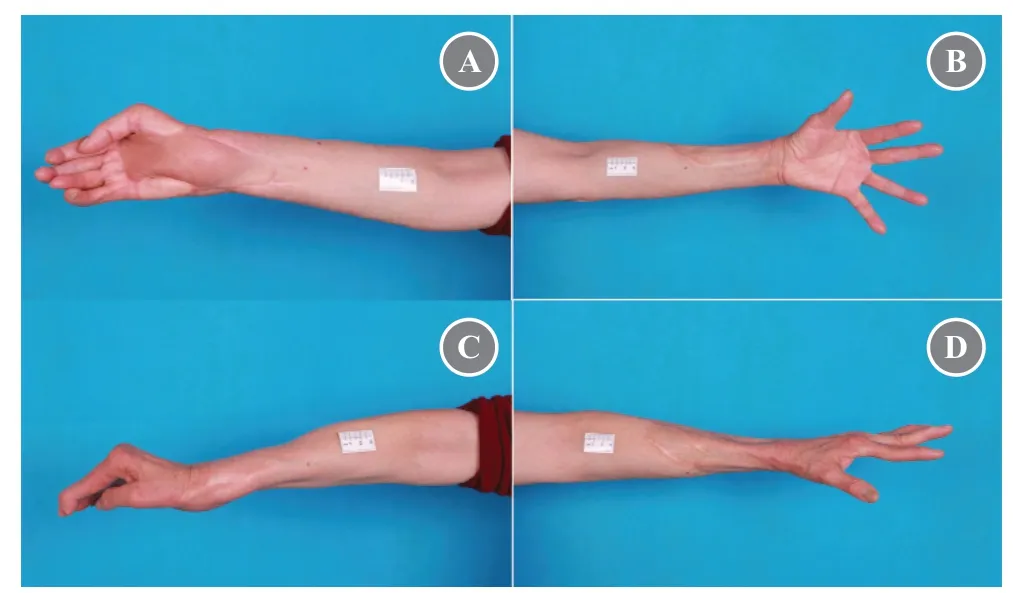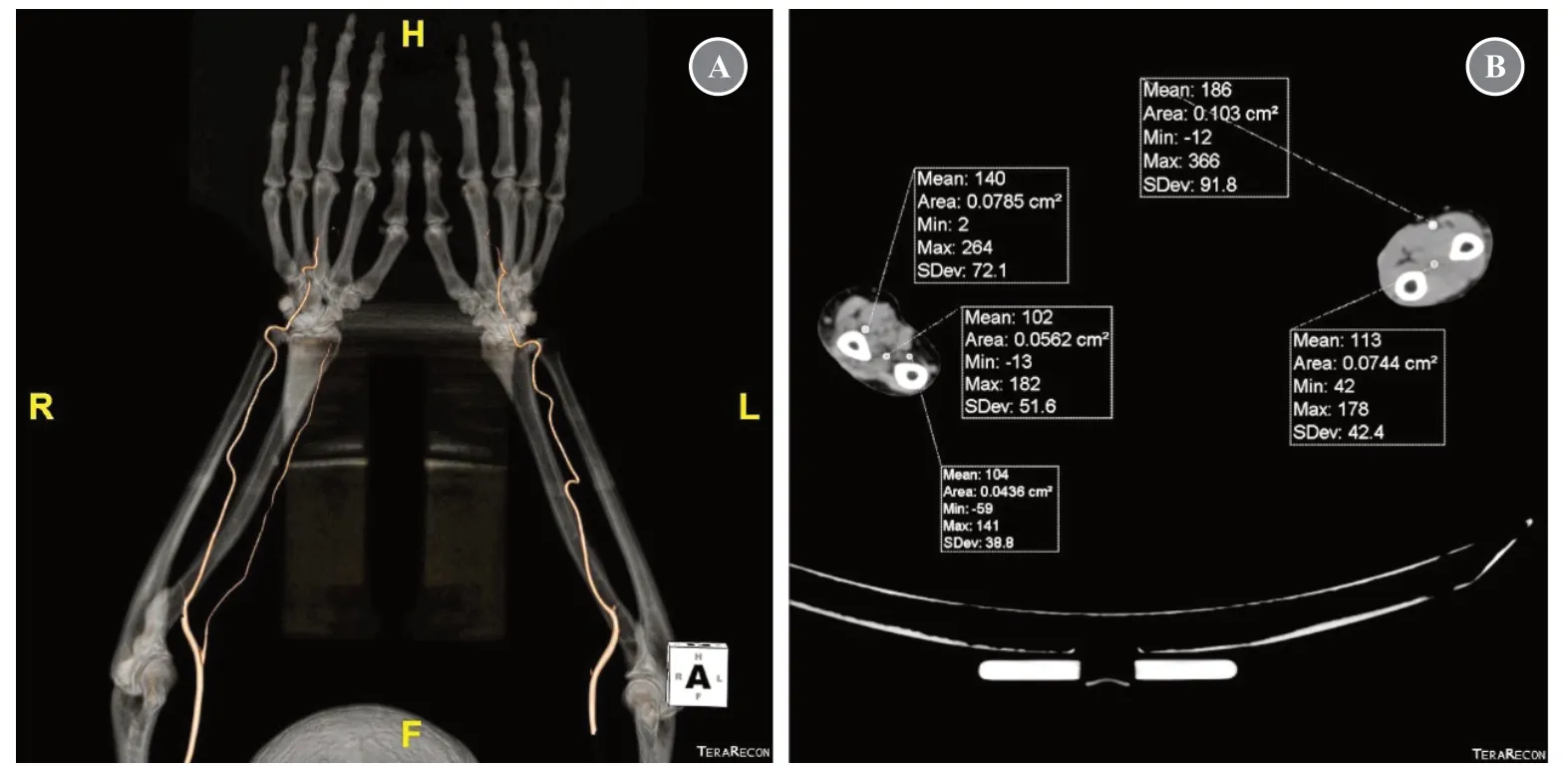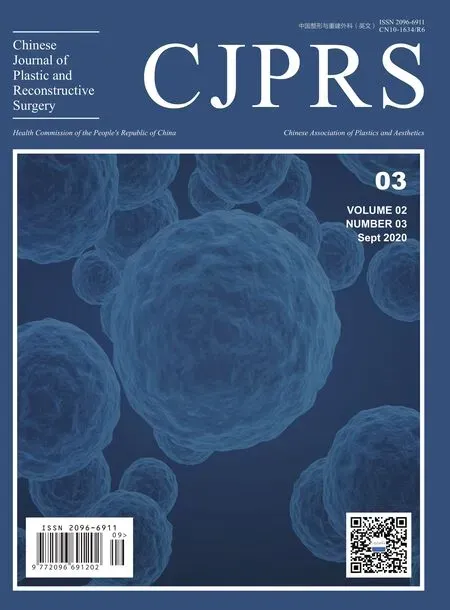The First Case of Free Radial Forearm Skin Flap:A 40-Year Follow-Up Study
Hongyi WANG,Bingyu GUO,Qiang HUI,Dongwen JIANG,Xiaoyan LIU,Kai TAO
Department of Plastic Surgery,General Hospital of Northern Theater,PLA
ABSTRACT Background The radial forearm skin flap (RFSF) was first introduced by the Chinese scholar Guofan Yang and has since been used for nearly 40 years.The many advantages of RFSF have been investigated in this study.Case presentation In this case,a female patient underwent RFSF surgery in 1979.In 2016 and 2018,two interviews were held to evaluate her subjective postoperative experience.In addition,overall donor site evaluation was conducted based on general health checkups and tests; tests for appearance,tactile sensitivity,muscle strength,and motor function; and CTA.Results The flap survived well,and the donor site recovered without hand necrosis in the 1970s.In 2018,the patient was in good health condition and expressed her satisfaction with the surgery.The patient did not suffer from any postoperative complications such as diminished sensation of the donor site or donor site dysfunction; in the evaluation of hand and finger function,there was no point where functional reduction of the donor site was noted.CTA revealed compensatory blood supply with enlargement in the diameter of the ulnar and interosseous artery.Conclusion After a nearly 40-year follow-up,the patient who underwent the first free radial forearm flap transplantation expressed satisfaction with the operative outcomes.The examination showed good results at the recipient site with little donor site deformities and good compensatory blood supply.
KEY WORDS Radial forearm skin flap; Free flap transplantation; Follow-up study
INTRODUCTION
Free radial forearm skin flap (RFSF) transplantation was pioneered in the Department of Plastic Surgery at the General Hospital of Northern Theater Command,PLA(also known as General Hospital of Shenyang Military Region,PLA),[1]by Dr.Guofan Yang in 1979.Dr.Yang studied the surgical viability of the forearm skin flap with 35 fresh human cadavers in the 1970s before using it in the clinical setting.An operating microscope was used for the observation and evaluation of vascular perfusion and radiographic images.The RFSF was unique for its extralong pedicle using the trunk artery and reliable blood supply via the radial vessels,with consistent anatomy and a wide diameter,facilitating anastomosis.Ever since,it has become an ideal choice for head and neck reconstruction[2-6].
Forearm skin flap surgeries have been performed at our department for years since the pioneering surgery.From March 1979 to December 2018,a total of 869 patients underwent RFSF transplantations.Despite the long history of this procedure,until now,there has been little information on the first case of RFSF transplantation in the western world,including the pioneers and long-term follow-up results.This study reports the history of the first case of RFSF transplantation and its nearly 40-year follow-up results.
CASE PRESENTATION
On March 29,1979,the patient was a 35-year-old female who was diagnosed with contracture deformity on the right forearm and palm with defects in the median nerve,flexor tendon,and skin soft tissue.She had a crush injury approximately 28 months previously.The transplanted RFSF flap was taken from the donor site on the left forearm (Fig.1).The patient’s basic information is shown in Table 1.

Fig.1 Photos of the first case of RFSF

Table 1 Patients’ basic information
Initial follow-up conducted in 1979 revealed that the flap survived well,and the donor site recovered without hand necrosis.During the long-term follow-up on November 23,2016,and August 13,2018,she was in a good health condition and was very satisfied with the operative outcome.There was no significant postoperative dysfunction or loss of sensation at the donor site,and she reported no numbness or sensation of cold compared to the preoperative condition.
By gross observation,the appearance of the forearm skin flap donor site was normal,with some brown pigmentation.
The donor site wound had been covered by free skin transplantation after the removal of the donor flap.The split-thickness skin was taken from the thigh.Review of the original medical records confirms that the forearm skin flap donor site was successfully covered by free skin graft at the time of the original surgery,with no infection or any other complications (Fig.2).

Fig.2 Appearance at the follow-up 40 years after RFSF transplantation.
The patient was able to grip the handgrip dynamometer.Little difference was observed between the right (4.3 ±1.2 kg) and left (7.6 ± 2.4 kg) hands.She had some small difficulty gripping due to the impact of the original injury on the non-donor hand.However,in general,the patient’s average grip strength was almost the same as the normal handgrip strength,considering the patients’ age,sex,and size.
Hand examination comprised examination of flexion,hyperextension,and dorsiflexion,median nerve test,and abduction finger testing; additionally,hand muscles and nerve systems tests were performed.All results obtained were good in this case.
The CTA results showed that after surgery,the radial artery at the donor site had a defect resulting from the transplant surgery.The patient’s ulnar artery was stronger than the other hand,and the blood supply was via the ulnar artery (Fig.3).Furthermore,where the radial artery was removed,atresia had resulted in the surplus radial artery at the proximal ends.

Fig.3 CTA imaging of both forearms
DISCUSSION
The long-term study of this patient confirms the surgeons’original hypothesis regarding the anatomy of the forearm skin flap and its blood supply.After the application of 869 cases of RFSF transplantation by the surgical team at the General Hospital of Northern Theater Command,PLA,in the years following this pioneer surgery,we believe that RFSFs have many advantages,such as small variation of vascular anatomy,large diameter and easy anastomosis,good soft and plasticity,simple surgical anatomy,and easy operation.
Despite the enlargement of both ulnar and interosseous arteries according to CTA scan,the chief blood supply was found via the donor forearm in the first case.Some other patients who underwent RFSF transplantation have also shown a chief interosseous arterial blood supply.As it appears unpredictable which artery the body will choose to compensate with,we recommend that surgeons take equal care to protect the viability of the interosseous artery in forearm skin flap surgery,in case atresia occurs.This viability may be important in the recovery of the donor site.In addition,as the remaining radial artery shrinks,atresia results,and the artery becomes useless.Previously,surgeons faced challenges about whether radial arterial repair was available after the flap surgery[7-14].Surgeons took care during surgery to reduce the defect.These long-term results demonstrate that when the forearm skin flap is used,it does minimal harm to the donor site.
In clinical practice,the surgical team at the General Hospital of Northern Theater Command,PLA,has since further experimented with using this flap by local transfer without radial artery cutdown.An autologous saphenous vein or artificial vessel was also experimented for radial arterial repair once the forearm flap was removed.As developments have been made in tissue engineering,we have also tried to suture the two sides using artificial vessels.Remarkable progress has been made in the flap surgical techniques,but additional long-term follow-up is necessary before any firm conclusions can be drawn about experimental surgical techniques.
CONCLUSION

Fig.4 Professor Guofan Yang (1928-1997)
After a nearly 40-year follow-up,the patient who underwent the first free radial forearm flap transplantation was satisfied with the operative results.The examination showed good results at the recipient site with little donor deformity and good compensatory blood supply.Although nearly 40 years have passed since the first case of free radial forearm flap transplantation,the innovation spirit can still be felt and worthy of admiration today (Fig.4).
ETHICS DECLARATIONS
Ethics Approval and Consent to Participate
N/A as it is a case report.
Consent for Publication
All the authors have consented for the publication.
Competing Interests
The authors declare that they have no competing interests.The authors state that the views expressed in the submitted article are their own and not the official position of the institution or funder.
 Chinese Journal of Plastic and Reconstructive Surgery2020年3期
Chinese Journal of Plastic and Reconstructive Surgery2020年3期
- Chinese Journal of Plastic and Reconstructive Surgery的其它文章
- Status Quo and Future Development of Female Genital Cosmetic Surgery (Intimate Surgery)
- A Case of Digital Superficial Angiomyxoma
- Meteorological Influence on Tissue Expander-Related Major Infection
- Surgical Management for Diabetic Foot Ulcer:A Bibliometric Study
- Programmed 6-Step Approach of Improved Liposuction-Curettage for Axillary Bromhidrosis
- Foreword from Professor Lee L.Q.Pu
